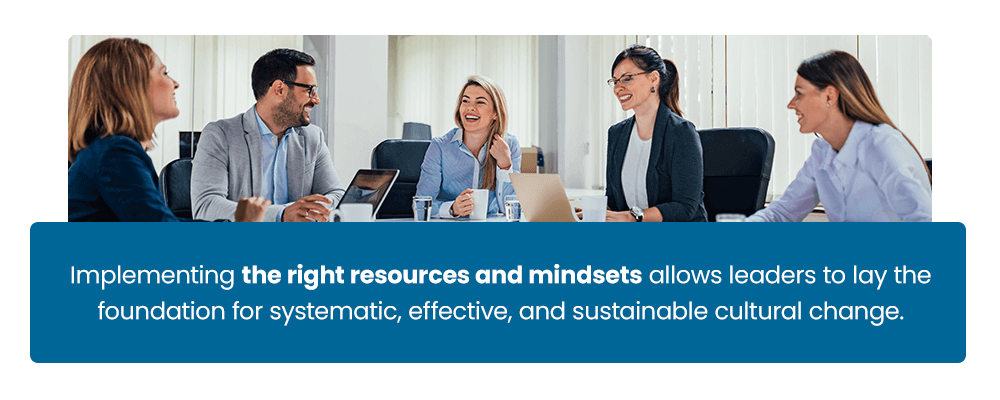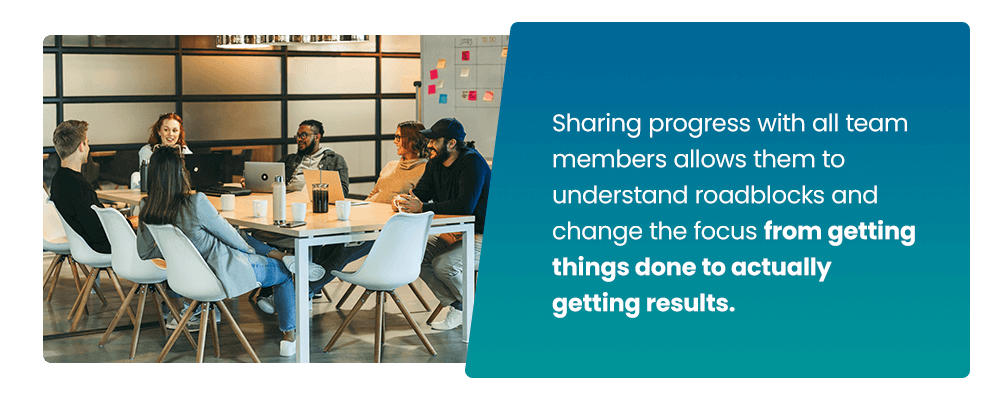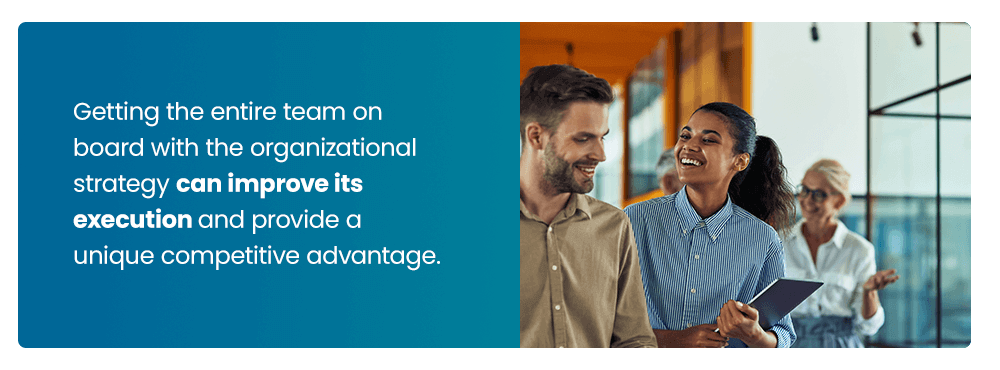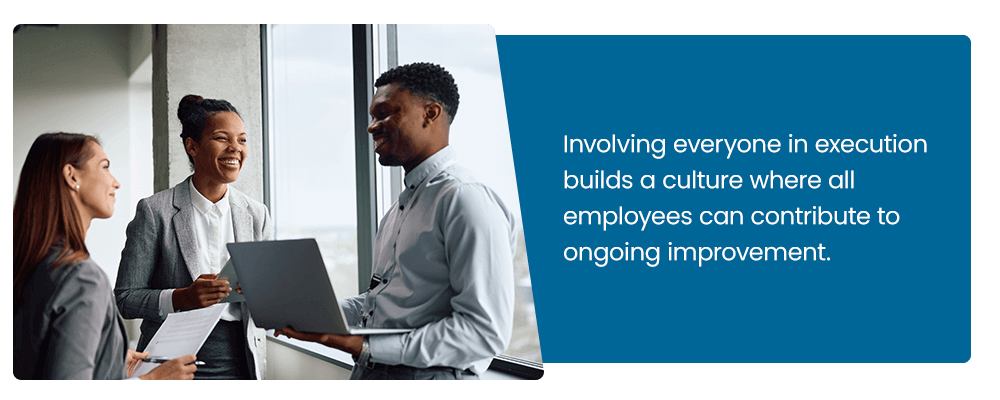Cultural transformation doesn’t happen all at once. It requires patience and concentrated focus to build the stepping stones for a new way of thinking in your business. When organizations adjust their values and ideals, they typically go through four stages, each building on the one before it. If you want to transform your company’s culture, understanding the purpose and stages of cultural change is a crucial first step.
In This Article
- What Is Cultural Transformation?
- A Four-Stage Cultural Transformation Framework
- Create Long-Lasting Change With AchieveIt
What Is Cultural Transformation?
Cultural transformation is the process of changing the values, beliefs, and behaviors of individual employees to better align with the organization’s mission and goals. By the end of a cultural shift, employees should have a crystal-clear picture of what the organization stands for, what sets it apart, and what goals it aims to achieve. Understanding these core components helps employees make better decisions and drive long-lasting success across the company.
While a healthy organizational culture might sound like a “nice-to-have,” it frequently shows up as the common denominator for successful businesses. McKinsey even found that cultural challenges were the biggest barrier to seeing results from digital investments. Even if you invest in a shiny piece of technology, you’ll need the right culture if you want to see results.
Some of the steps that contribute to this change include:
- Accurately evaluating and understanding the organization’s unique culture and challenges.
- Ensuring a fully informed, engaged, and communicative leadership team that knows the difference between action and results.
- Crafting a strategy and vision that aligns with business goals.
- Engaging and rewarding employees with relevant, meaningful incentives.
- Hiring workers who fit well in your new plan.
- Regularly measuring, assessing, and sharing your progress with all employees.
While these steps occur across the four stages we’ve identified, this process never truly stops. The last stage of a cultural transformation sets your organization up for ongoing innovation, with your employees empowered and capable of continuously improving. You’ll also need to adjust your approach as your business and industry evolve.
These large-scale shifts in thinking can facilitate benefits that range from efficiency and employee satisfaction to a more trusting, collaborative workforce. Cultural transformation occurs across the entire organization, but it starts with leadership. Implementing the right resources and mindsets allows leaders to lay the foundation for systematic, effective, and sustainable cultural change.

A Four-Stage Cultural Transformation Framework
Before a company can truly experience a sustainable cultural shift, it must build certain qualities that support its goals. These competencies generally align with these four stages of cultural transformation.
Stage 1: Collaboration
The first stage focuses on collaboration, which most organizations will develop naturally as they identify a need for a cultural shift and start making plans. The company creates a shared vision, and executive teams and leaders collaborate to make it a reality. A flurry of activity ensues, which makes many teams think they’re making great progress.
Unfortunately, activity doesn’t equate to results. To bridge that gap and reach the next stage, businesses must connect activity to performance targets and track it effectively. Instead of simply staying busy, leaders must clearly define their desired results and understand what activities will get them there. With a clear vision, teams understand how their work impacts the rest of the organization and can collaborate more effectively.
In this first stage of cultural transformation, well-aligned measurements are crucial. Rather than just tracking activities, organizations must look at results, ensuring that all the activity is worthwhile. This tracking should happen with full transparency, allowing all team members to be involved and see the meaning of the work.
When teams work in siloes, they cannot make fully informed decisions. Sharing progress with all team members allows them to understand roadblocks and change the focus from getting things done to actually getting results. If you find your progress happening slowly, you may need to focus on this stage and make the shift from checking tasks off a to-do list to making progress.

Moving from Stage 1 to Stage 2 is often one of the most difficult shifts for businesses because it requires three foundational changes:
- Prioritizing outcomes over activity: Leaders and team members must understand the importance of tracking measurable outcomes over completing individual tasks. Permeating this idea throughout the business gives team members a clear focus and allows them to see the progress of the entire group.
- Connecting tasks to firm due dates and performance objectives: Those measured tasks should have firm deadlines and support your objectives. With due dates and strong measurement, you create a strategic plan that helps individuals take meaningful action and follow the plan.
- Empowering managers through transparency: Giving all managers insights into the company’s progress, including regular updates on implementation and organizational performance, allows them to monitor team performance. They can take initiative as necessary to support overall goals.
In the first stage, businesses develop organizational accountability through collaboration. The next step zeroes in on individual accountability, which can only happen when the company works together as a team and measures progress along the way.
Stage 2: Individual Accountability
Moving from organizational accountability to individual accountability calls for the commitment of front-line workers. Getting the entire team on board with the organizational strategy can improve its execution and provide a unique competitive advantage. Still, this effort is challenging. The company must ensure a cohesive, well-aligned vision, mission, and strategy and help employees connect with them.

You can help team members relate to these elements by linking them to the team members’ roles. Show how each individual contributes to the company’s overall mission and vision, encouraging the employee to use their unique position and skills to create change. This clarity is especially important if your mission and vision direct your strategy. When these elements align, you can share strategic imperatives across all teams — from the executive board to middle management to front-line employees.
Realizing individual accountability also requires the right resources. Some tools used in this stage of cultural transformation include:
- Scorecards: Scorecards at the organizational, departmental, and individual levels allow various players and teams to understand their parts in the bigger picture and stay accountable for success.
- Dashboards: Well-built dashboards can provide regular updates that measure progress and track results, helping everyone make more informed decisions and change course if needed.
- Measurable and quantifiable objectives: You’ll need trackable objectives to facilitate scorecards and dashboards and successfully evaluate your progress over time.
- Strategies and tactics that support the objectives: Aligning methods with objectives ensures your measurements provide real results.
- Individual assignments with due dates: Clearly outlining responsibilities allows individual employees to take charge of objectives, strategies, and tactics.
- Regular progress review meetings: Get together at least once a month to keep your efforts top of mind and strategize with team members as needed.
By this point, your organization will have used Stage 1 to develop a company-wide focus on strategy and deliver the resources and mindsets required to create individual accountability in Stage 2. For example, Stage 1’s collaboration can reduce internal competition between teams that might impede the ultimate goal. Other advantages include better resource allocation based on each team’s needs and more pervasive commitment to the objective throughout the company.
With these in place, you can head to Stage 3.
Stage 3: Effective Execution
Stage 3 focuses on the process of executing the plan. It connects the resources, ownership, and knowledge of the strategy to ensure effective and efficient implementation. This goal calls for initiatives in many different areas of business.
We’ve identified five elements of Stage 3 required for successful cultural transformation at your organization:
- Employee connections to mission, vision, and strategy: Build upon your efforts in Stage 2 by emphasizing each employee’s connection to the company’s overarching plan and priorities. Have each person make a personalized mission, vision, and strategy statement through a commitment card. These cards start with, “I will help my company fulfill its mission, execute its strategy, and achieve its vision by doing the following every day as part of my job.” Include the cards in the worker’s personnel file, and use them for evaluations and performance reviews.
- Ongoing communications: The 7×7 method of communication asks you to communicate your strategy seven times in seven different ways. After those seven times, you do it again. This approach shares the strategy as much as possible to help it sink in. Multiple means of communication also help you connect with employees who may learn best in specific channels, such as reading over listening. Building up your team’s knowledge of the strategy can help them make more effective decisions.
- Strategy discussions during orientation: Consider strategy during the hiring and onboarding processes. Look for candidates who seem like a good fit with your cultural shift, and ask new hires to create commitment cards within their first 90 days. These tasks can help create your desired culture from the start.
- Reward the positive influencers in the company: By creating reward and recognition programs, you can celebrate the employees who create the most impact on your strategy. They incentivize other employees to change their own behaviors and create natural motivation for strategic execution.
- Post dashboards and scorecards: Give everyone insights into organizational progress with these visual tools, which can keep the plan top of mind and promote a more collaborative approach. Split your focus evenly among company and department-specific objectives.
These five tips can help you engage employees throughout execution, building a sense of purpose, meaning, and urgency. They also support employee satisfaction while driving the company toward your desired results.
Once employees fully understand the connection between individual performance, vision, and execution, they can cultivate a new organizational dynamic. They become engaged in strategy execution to make better decisions, identify opportunities for improvement, and question the status quo. As integral parts of strategy discussions, these employees create the foundation for big innovations.
Stage 4: Sustainable Innovation
With these elements in place, companies experience a competitive advantage. Every employee supports the strategy, mission, and vision, naturally improving overall performance across measures like customer and employee satisfaction and the quality of your product or services. Pairing these benefits with solid strategy and strong execution offers an unmatched opportunity for increasing your market share.
Involving everyone in execution builds a culture where all employees can contribute to ongoing improvement. Innovation often comes from the team members on the front lines, as they work extensively and closely with your product or service. They understand strengths and weaknesses and see how customers interact with your offerings, including unexpected or unique uses. Front-line workers can see these gaps and identify boundless opportunities that executives often overlook.

Without a clear understanding of the company’s strategy or their role in it, these employees cannot drive significant, long-term breakthroughs. And without a method for capturing these ideas, the company cannot use them effectively. To move from Stage 3 to Stage 4 and facilitate market differentiation, workers must have the appropriate resources and mechanisms for moving innovation up the corporate ladder.
Some of these resources include:
- Innovation-oriented skills: Innovation doesn’t happen by chance or stumbling across an innovative worker. Instead, leaders must cultivate skills like challenging industry beliefs, identifying unmet or unarticulated customer needs, generating ideas in a structured manner, and turning ideas into business concepts.
- Motivation: Financial targets may not offer sufficient motivation for front-line workers, but more inspiring, strategic goals can be more compelling. Find important issues that resonate and empower employees.
- Connections to others: Innovation is collaborative, with ideas morphing and iterating as other contributors join in. Plus, its benefits often come from the emotional and social rewards of a job well done. Leaders can support these benefits by fostering connections between employees during the innovation process and sharing and recognizing their ideas.
- Process transparency: Many potential innovators fall short of bringing their ideas to life due to unknown processes. They don’t know how to follow through with a suggestion or whether they’ll receive recognition. Push past these hesitancies with a clear and transparent process that outlines decision-makers and criteria.
- Systemic support: To cultivate innovation on the front lines, you’ll need support systems in many different areas, from leadership and structure to incentives and processes. Ensure your objectives for cultural transformation resonate in as many places as possible.
By establishing these resources, you cultivate a mindset of innovation and provide the means for making the most of it. A sustainable system can carry these new ways of thinking forward and unlock exponential competitive advantages.
Create Long-Lasting Change With AchieveIt
Moving through these four stages requires patience and concentrated effort, but the rewards are well worth it. Instead of meeting an objective, you can cultivate the skills and ideologies to reach future goals more effectively and enjoy various advantages along the way.
We’ve mentioned the importance of resources several times, and one of the most valuable tools in cultural transformation is your system for strategic planning and execution. Dedicated software supports efforts throughout the four stages, like communication, collaboration, progress tracking, and alignment. We built the AchieveIt platform for every step of the process and every part of the company. Our implementation experts can also help you craft an effective plan using data-driven methods.
Request your demo today or take a live product tour to see AchieveIt in action and kick-start your cultural transformation.



